Related Research Articles

Pushmataha County is a county in the southeastern part of the U.S. state of Oklahoma. As of the 2020 census, the population was 10,812. Its county seat is Antlers.
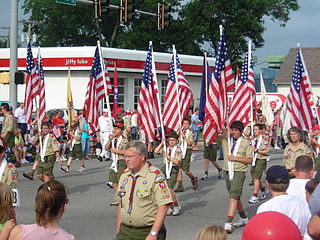
Scouting in Oklahoma has a long history, from the 1910s to the present day, serving thousands of youth in programs that suit the environment in which they live.

McAlester is the county seat of Pittsburg County, Oklahoma. The population was 18,363 at the time of the 2010 census, a 3.4 percent increase from 17,783 at the 2000 census. The town gets its name from James Jackson McAlester, an early settler and businessman who later became lieutenant governor of Oklahoma. Known as "J. J.", McAlester married Rebecca Burney, the daughter of a full-blood Chickasaw family, which made him a citizen of the Chickasaw Nation.

Tuskahoma is an unincorporated community and census-designated place in northern Pushmataha County, Oklahoma, United States, four miles east of Clayton. It was the former seat of the Choctaw Nation government prior to Oklahoma statehood. The population was 102 as of the 2020 United States census.
Chahta Tamaha served as the capital of the Choctaw Nation from 1863 to 1883 in Indian Territory. The town developed initially around the Armstrong Academy, which was operated by Protestant religious missionaries from 1844 to 1861 to serve Choctaw boys. After the capital was relocated to another town, this community declined.

Choctaw Casinos & Resorts is a chain of seven Native American casinos and hotels located in Oklahoma, owned and operated by the Choctaw Nation of Oklahoma.
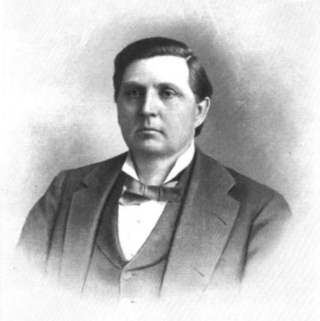
Douglas Hancock Cooper Johnston, also known as "Douglas Henry Johnston", was a tribal leader who served as the last elected governor of the Chickasaw Nation from 1898 to 1902. He was re-elected in 1904.
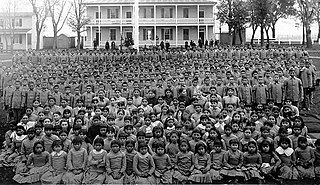
American Indian boarding schools, also known more recently as American Indian residential schools, were established in the United States from the mid-17th to the early 20th centuries with a primary objective of "civilizing" or assimilating Native American children and youth into Anglo-American culture. In the process, these schools denigrated Native American culture and made children give up their languages and religion. At the same time the schools provided a basic Western education. These boarding schools were first established by Christian missionaries of various denominations. The missionaries were often approved by the federal government to start both missions and schools on reservations, especially in the lightly populated areas of the West. In the late 19th and early 20th centuries especially, the government paid Church denominations to provide basic education to Native American children on reservations, and later established its own schools on reservations. The Bureau of Indian Affairs (BIA) also founded additional off-reservation boarding schools. Similarly to schools that taught speakers of immigrant languages, the curriculum was rooted in linguistic imperialism, the English only movement, and forced assimilation enforced by corporal punishment. These sometimes drew children from a variety of tribes. In addition, religious orders established off-reservation schools. In October 2024, U.S. President Joe Biden issued an official apology on behalf of the federal government for the abuse suffered in these boarding schools. In his apology, Biden discusses the history of boarding schools and blames the government for not apologizing sooner. He recognizes this kind of apology had never been issued before and addresses it to a crowd of Indigenous people.

Bloomfield Academy was a Chickasaw school for girls founded in 1852 by the Reverend John Harpole Carr, located in the Chickasaw Nation in Indian Territory, about 3 miles (4.8 km) southeast of the present town of Achille, Oklahoma. A boarding school funded by both the Missouri Conference of the Methodist Church and the government of the Chickasaw Nation, it operated there until 1914, which a major fire destroyed most buildings. Now privately owned, the site of the former academy near Achille was listed on the National Register of Historic Places in 1972.
Lyceum is a former academic community in northern Pushmataha County, Oklahoma, United States, located two miles west of Tuskahoma.
Cedar County was a political subdivision of the Choctaw Nation in the Indian Territory. The county formed part of the nation’s Apukshunnubbee District, or Second District, one of three administrative super-regions.
Johns Valley is a geographic feature and place name located in the Kiamichi Mountains in northwestern Pushmataha County, Oklahoma. The valley is formally classified by geologists as a "basin" due to its complete encirclement by mountains.
The Pushmataha County Historical Society is a historical society devoted to collecting and preserving the history of Pushmataha County, Oklahoma, United States. It is headquartered in the historic Frisco Depot in Antlers, Oklahoma, which it operates as a public museum.

The Choctaw Capitol Building is a historic building built in 1884 that housed the government of the Choctaw Nation of Oklahoma from 1884 to 1907. The building is located in Pushmataha County, Oklahoma, two miles north of the community of Tuskahoma.

The Choctaw code talkers were a group of Choctaw Indians from Oklahoma who pioneered the use of Native American languages as military code during World War I.
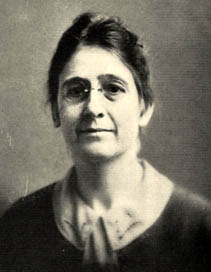
Anna Lewis (1885–1961) was a noted teacher, historian and writer, who specialized in American history, and particularly the history of the Southwest. Born in what was then Indian Territory to a family of mixed Choctaw and European ancestry, she earned doctoral degrees from University of California, Berkeley (1915) and University of Oklahoma (1930). She was the first woman to receive a Ph. D. at the University of Oklahoma. Lewis spent her educational career at the Oklahoma College for Women. She wrote two books and numerous articles for publications in her area of interest before retiring in 1956 to a home she had built in southern Oklahoma. She died in 1961.
Agawam is a ghost town in Grady County, Oklahoma.
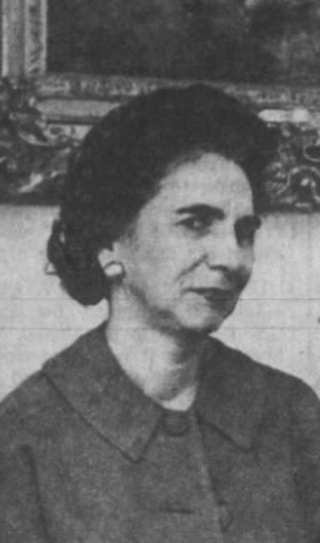
Harriet Wright O'Leary was an American teacher and politician. She was the first woman to serve on the tribal council of the Choctaw Nation of Oklahoma and the first woman to vie for the position as Principal Chief.

Jane Austin McCurtain was a Choctaw educator and political advisor within the Choctaw Nation, known for her influence on educational and tribal governance throughout her life. Serving as a close advisor to her husband, chief Jackson McCurtain, and later to his successors, she held key roles in Choctaw education, including as superintendent of Jones Academy, and remained active in Choctaw political affairs until her death, serving as custodian of the Choctaw Council House in Tuskahoma.
References
- ↑ Jones, W. N. (December 5, 1819). "No. 46, An act to authorise the Board of Education to let contracts for conducting the several new Academys and naming the same" (PDF). Library of Congress.
{{cite web}}: CS1 maint: url-status (link) - ↑ Debo, Angie (1961). The Rise and Fall of the Choctaw Republic (2nd ed.). University of Oklahoma Press. p. 239.
- ↑ "Tvshka Homma Female Institute Historical Marker". www.hmdb.org. Retrieved 2024-11-22.
- ↑ "Tannehill, Mintie Interview". www.okgenweb.net. Retrieved 2024-11-22.
- 1 2 "Tuskahoma Academy Destroyed by Fire Monday Afternoon". The Antlers American. Antlers, Oklahoma. 16 December 1926. p. 1 – via Newspapers.com.
- ↑ "Reopen Historic Academy". Harlow's Weekly. Oklahoma City, Oklahoma. 10 February 1922. p. 11 – via Newspapers.com.
- ↑ "Girls' School at Tuskahoma to be Opened". The Daily Oklahoman. Oklahoma City, Oklahoma. 26 August 1923. p. 42 – via Newspapers.com.
- ↑ "Auction Sale of Tribal Property". McAlester Democrat. McAlester, Oklahoma. 17 November 1927. p. 7 – via Newspapers.com.
- ↑ "O. C. W. Teacher to Restore Landmarks". The Chickasha Star. Chickasha, Oklahoma. 1 September 1932. p. 10 – via Newspapers.com.